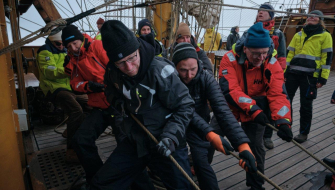Departure from Ushuaia

Start of our adventure along the Beagle Channel to the Drake Passage.
It was just after 10 in the morning when the Europa let go of her moorings from the port, at the same time that hands were called on deck to set some sail. Waving goodbye to some people who had gathered at the pier, topsails were sheeted down, and she sailed away from the harbour. First, with a little help from her engines to get off the lee of several other vessels that lay moored alongside, then just using the wind. And it was not just to leave Ushuaia that she spread some of her canvas, but she kept it for the rest of the journey. It is not usual to have fair winds all along the Beagle Channel to sail all the way to its Atlantic entrance and face the open oceanic waters leading to the Drake Passage. A great and spectacular farewell to the southernmost lands of South America and a fantastic welcome to the adventurous voyage that lies ahead of us.
A trip that requires many hands to steer the ship, keep a good lookout, and pull ropes to set or douse sails. For that, first, we all need to get acquainted with these procedures, and for that, there is no better moment than the confined waters of the Beagle Channel. Today was a time for instructions and familiarisations with the ship and everyone’s duties on board, such as steering, lookouts, rope and sail handling, and the always exciting directions on how to climb aloft.

A day of good sailing, a journey for training and learning, surrounded by the great landscapes of southern Patagonia. Lands first trodden by humans about 10,000 years ago, when the indigenous Yaghan people lived, fished, and used their canoes all along those channels, fjords, and bays. A seafaring culture, part of a large and diverse community of different native Patagonian inhabitants. They first saw Europeans when the Ferdinand Magellan Expedition, over 500 years ago, found a connection between the Atlantic and Pacific Oceans—straits that nowadays bear his name, located north of the large island of Tierra del Fuego. South of it lies the waterway we sailed today, explored, charted, and mapped during the two expeditions of the HMS Beagle between 1829 and 1836, first under the command of Pringle Stokes and then Robert FitzRoy. It was during the second expedition that the captain agreed to bring with him a companion, a man who, after his studies and reflections on what he saw and experienced during the voyage, was about to change the way we look at nature—Charles Darwin.
No matter whether we think of the old history counting several thousand years or the more recent times of the golden age of exploration and sailing, the notoriously changeable weather, rough seas, and strong winds remain an unchanging factor of the region’s characteristics. Modern cruise and cargo ships, sailing vessels, and fishermen all still have to endure them. And it was no exception for us today. Variable gusty winds between 25 and 35 knots blew throughout the day, gradually increasing as the seas grew, too, when the ship cleared the three islands that mark the entrance of the Beagle Channel: Picton, Nueva, and Lenox. It all made for a bit of a rough ride on a great first day of sailing, and for all new hands on board, a first contact with the spiderweb of lines that pull sails and yards, stretch or wrap up canvas. A system that will surely untangle as the days go by and the crew explain and train us on the use of all those ropes.

With her fine-looking appearance, as the Europa sails away along the Beagle, it is worth keeping an eye on both the sky and the water. Gliding around her and also taking advantage of the strong winds are black-browed albatrosses, giant petrels, flocks of cormorants, South American terns, and Chilean skuas. Here and there, over small islets or having a quick look amongst the waves, are Magellanic penguins. A humpback whale blows, and next to it, what seems to be a sei whale. In the afternoon, bow-riding the ship, a group of dusky dolphins.

There is only one creature that lives between sea and sky. She is a creature of mass, displacing tons of water, yet sensitive to the very breath of the wind. She rides the currents of oceans, shoulders their massive billows, and nods in respect to each passing ripple. Treading an unmarked path, leaving no trace, governed by the immutable laws of physics, yet promising untold freedom, a sailboat fulfils a sailor’s dream.
Garry Prater, Jan. 2003. A Sailor’s Dream
Surely, the idea of a sea voyage such as the one we just started aboard a classical tall ship, with a legacy as an ocean wanderer, inspires dreamy thoughts. A trip planned on legendary seas, mythical lands, and remote destinations on a vessel with a long and fascinating history. But as soon as the heeling, pitching, and jerking increase, when the swell washes over her decks, seasickness strikes hard. Then, the watches become thinner and thinner. Some don’t show up, or after a while, decide to return to their bunks. Many of the colourful faces at embarkation have become lighter and greener. The romantic ideal of a daring sea voyage, the wide-open sea ahead, and a sailboat begin to totter. Not to worry—soon, we will all be on our feet again. Faster or slower, we will overcome the motion sickness, and in the hours or days to come, we will see more of us around—eyes out at the sea during lookouts, hands on the wheel or a rope, even aloft. And, of course, enjoying… and keeping inside us… the great meals that the galley cooks daily.

